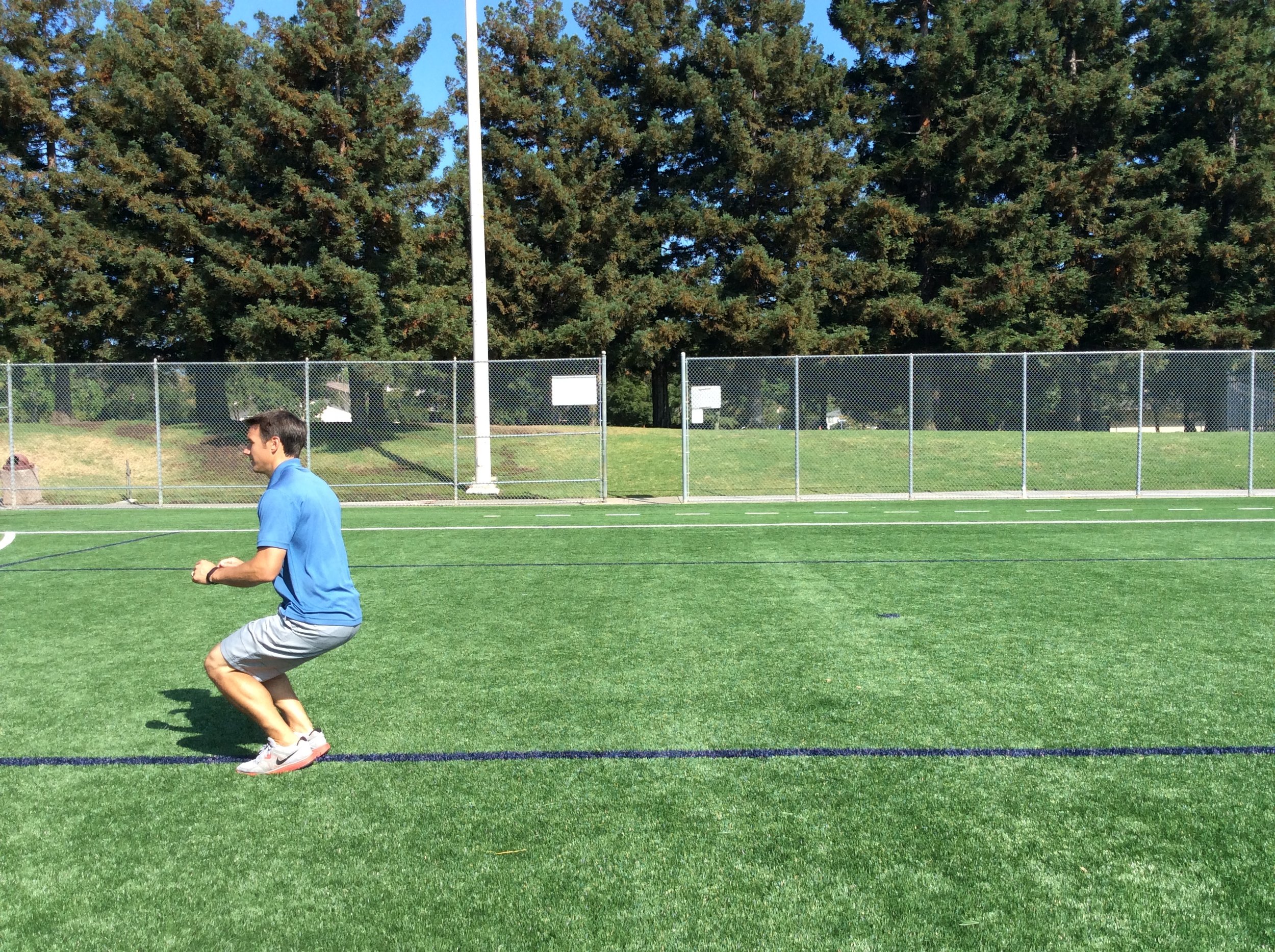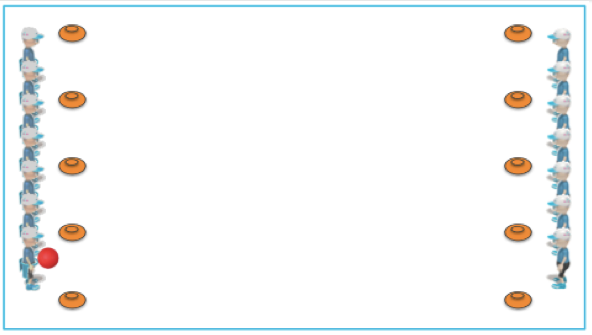TECHNIQUE
Today we are going to learn how to long jump.
IMPORTANCE
The long jump is important because it helps develop your speed, power, coordination, jumping ability, and strength as well as increase your total distance of your jump.
VOCABULARY
Long Jump: an athletic event in which competitors jump as far as possible along the ground in one leap.
When long jumping, it is important to:
1. Begin with a running start
2. Jump off one foot while using the proper jumping form
3. Land with your knees and hips bent to maintain balance.
PRACTICE:
- Line up at the baseline shoulder-to-shoulder. When I say, “GO!” take five running steps and jump using the proper technique for distance.
- When I say, "GO!" take five running steps from the baseline and this time focus on jumping for height.
- When I say "GO!" take five running steps from the baseline and jump both for height and distance.
JUMP THE GAP
TIME
15-25 minutes
NUMBER OF STUDENTS
2-25 students per game
EQUIPMENT
2 long jump ropes
2 short cones
STORYLINE
Today we are playing Jump the Gap. Your goal is to long jump across the gap without falling in!
INSTRUCTIONS
- I will divide the class into two groups.
- Before the game begins, line up at your marker cone.
- When I say, “GO!” both groups will send one student at a time to long jump over the gap.
- If you fall in the gap or if any part of your body touches the ropes, you will have to try again.
- You will get two chances to jump across.
- We will begin a new game when everyone has jumped the gap at least once
Game 1: Play as indicated above. Increasing the length of the gap by one foot each time. Students must take off on two feet and land on two feet.
Game 2: Play as indicated above. Increasing the length of the gap by one foot each time. Students can take a 10-foot running head start.
Game 3: Play elimination rounds. Eliminated students can either be judges, line markers, cheer on their teammates, or practice their long jumps to the side.
Exit Ticket: Students perform three long jumps, off the run, on their way to line up and go back to class.
TEACHING TIPS
- Approach:
- Remind students, jumps only count if they are controlled. This means that if they are falling over or stumbling when they land, they are jumping too far at once.
- ELL Accommodation:
- Post labeled pictures of skills and game play.
- Partner with proficient English speakers for directions/modeling and reflections.
- SpEd Accommodation:
- Set individual goals for physical or behavioral modifications.
- Model skills in a small group.
- Allow students to demonstrate skill one-on-one with teacher.
- Allow students extra time to master the skill.
- Use standards from previous grade levels to measure growth and progress.
- Reflection:
- What is a long jump?
- How can it help you as a competitors?
- What can I do to improve my long jump?
JUMP BALL II
TIME
20-30 minutes
NUMBER OF STUDENTS
4-20 students per game
EQUIPMENT
10 short cones
1 small playground ball
1 flag per 2 students
OBJECTIVE
Today we are playing Jump Ball. In this game, the objective is to long jump down the field to score in your opponent’s end zone.
INSTRUCTIONS
- I will divide the class into two teams (using flags) and select one team to begin with the ball in their end zone.
- If you have the ball:
- You can take three steps and long jump before you pass the pass
- You can pass the ball to anyone on your team, except the person that passed it to you.
- You must keep one foot planted on the ground (pivot foot).
- If you catch the ball you must jump while catching it.
- If you do not have the ball, you can move around the field to get open or play defense.
- The defensive team is trying to knock down or intercept the ball, but must stand three feet away from the student that is passing the ball.
- If the pass in incomplete (hits the ground) or goes out-of-bounds, the defensive team gets possession of the ball where it landed (even if the defensive team hit it last).
- We will begin a new round when one team scores.
Game 1: Play as indicated above.
Game 2: Give students a 10-second time limit (the defender counts out loud) to pass the ball to a teammate.
Variation: Consider adding a second ball to increase participation.
Exit Ticket: Students perform three long jumps, off the run, on their way to line up and go back to class.
TEACHING TIPS
- Safety:
- Remind students to be in control when long jumping so that they avoid tripping or stumbling.
- ELL Accommodation:
- Post labeled pictures of skills and game play.
- Partner with proficient English speakers for directions/modeling and reflections.
- SpEd Accommodation:
- Set individual goals for physical or behavioral modifications.
- Model skills in a small group.
- Allow students to demonstrate skill one-on-one with teacher.
- Allow students extra time to master the skill.
- Use standards from previous grade levels to measure growth and progress.
- Reflection:
- What is a long jump?
- How can it help you as a competitor?
- What can I do to improve my long jump?
LONG JUMP EVENT
TIME
15-25 minutes
NUMBER OF STUDENTS
No restrictions
EQUIPMENT
2 short orange cones per 6 students
1 yellow, green, red, blue, and purple short cone per 6 students
OBJECTIVE
Today we are playing Olympic Long Jump Event. In this game, the objective is to compete in the long jump event.
INSTRUCTIONS
- I will divide the class into groups of six.
- Before the game begins, choose which country you would like to represent in your group.
- Each student will receive a marker cone to mark their jumps.
- When I say, “GO!” the first student in line will begin with a running start then long jump as far as possible.
- Once you have jumped, place your marker cone where your feet have landed and get back in line.
- Each student will have three turns to long jump. Only move your marker cone if your jump was farther than your first attempt.
- After everyone has long jumped three time, the three students with the farthest jumps will move onto the final round where they will jump an additional three times while the other students mark their jumps.
- After the students finish the second round, the student with the farthest jump wins the gold medal for his/her group.
Game 1: Play as indicated above. Have students participate in different groups.
Game 2: Have the gold medalists from each group to compete in a final round.
Exit Ticket: Students perform three long jumps, off the run, on their way to line up and go back to class.
TEACHING TIPS
- Approach:
- Remind students, jumps only count if they are controlled. This means that if they are falling over or stumbling when they land, they are jumping too far at once.
- Discuss with students beforehand that this is a winning and losing game and if students do not feel comfortable they can participate with the noncompetitive groups.
- ELL Accommodation:
- Post labeled pictures of skills and game play.
- Partner with proficient English speakers for directions/modeling and reflections.
- SpEd Accommodation:
- Set individual goals for physical or behavioral modifications.
- Model skills in a small group.
- Allow students to demonstrate skill one-on-one with teacher.
- Allow students extra time to master the skill.
- Use standards from previous grade levels to measure growth and progress.
- Reflection:
- What is a long jump?
- How can it help you as a competitors?
- What can I do to improve my long jump?






